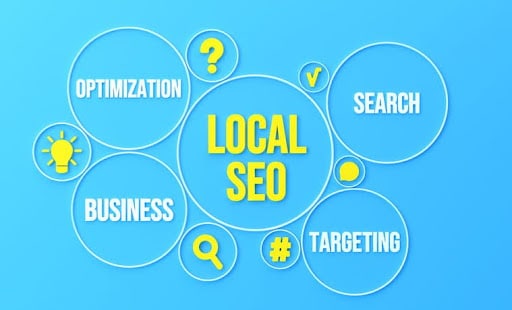What Is Local SEO?

Local SEO is a practice that optimizes a business’s online presence to rank higher in local search results. Like other search engine optimization (SEO) strategies, the goal is to rank a website on top of search engines such as Google and Bing. However, with local SEO, the focus is on catching the attention of users in a targeted geographical region, such as a city or neighborhood.
Local SEO ensures a business is recognized by people in the area it serves — people who can place orders or walk into the business.
Get professional search engine optimization services for your local business. Request a quote now.
What Is the Importance of Local SEO?
Typically, search engines prioritize local results. If a user searches for a term related to a business, the respective search engine will consider their location to provide relevant results. That’s why a business should aim at employing local SEO techniques to be among the results a user gets.
When your business is visible among local customers, your conversion rates can be high. For example, if you are a restaurant owner, and you appear on the results of a local user looking for a place to dine, they are more likely to place an order or book a reservation. If you mainly appear on the results of people not nearby, you may have many people visiting your website, but this may not be translated into the number of sales.
Additionally, if you employ the right local SEO strategies and rank higher on a local search engine results page (SERP), a user is more likely to choose you, giving you an advantage over competitors who don’t appear on top or don’t apply local SEO in their marketing approaches.
How Rankings Work in Local SEO
If numerous businesses within one geographic area apply local SEO techniques, who will receive the top spot on the results pages?
Search engines usually consider certain factors to determine how businesses rank. These include:
Proximity
Search engines use the distance between users’ and companies’ addresses to rank results. The business nearest to the searcher’s location is more likely to appear top of the list.
Search engines automatically use a user’s current location; users must turn on their device’s location setting for this to work.
Relevance
The businesses that rank higher on search engines usually have content that closely aligns with a user’s search query. Thus, it’s important for businesses to use relevant keywords and offer informative content.
The keyword “electrician in (city Y)” matches the search query “electrician near you in city Y.” The keyword “Italian restaurant in (neighborhood X)” is relevant to the search query “Italian restaurant near me” from a user in neighborhood X, and so on.
Prominence
The prominence factor focuses on how well-known a business is in its local market. A company with many positive reviews on its website or renowned review platforms, backlinks from other websites, and high engagement on social media can be considered popular in this context. Accordingly, it can rank higher in local SERPs.
How To Optimize Your Business for Local SEO
You can optimize your business for local SEO using several strategies. You need to employ each correctly to maximize the benefits. Also, learn more to determine the best way to apply the strategies according to your business’s needs.
Here is how to optimize your business for local SEO:
Optimize GBP (Google Business Profile)
Google Business Profile (GBP) is a tool from Google that allows businesses to control how they appear on search results and Google Maps. With a GBP, users can find you and obtain the needed information without scrolling through pages. They can know your name, address, phone number, working hours, and services. You can also add positive online reviews.
To benefit considerably from your GBP:
Ensure Proper NAP Information
Confirm that your business’s name, address, and phone number (NAP) are accurate in your GBP. These details should be consistent across all your platforms — your website, social media pages, and online directories. Regularly check your NAP everywhere to make any needed changes.
If you have multiple businesses, have a GBP for each location. Moreover, if you move to a new location or change your phone number, make the necessary changes on your GBP and other platforms.
An accurate NAP ensures you don’t miss out on business. For example, if you put the wrong address, Google may not rank you when a user near you searches for your services. Businesses with accurate addresses that can be compared to the user’s will be advantaged.
Add a Description Targeting the Main Keyword
It’s vital to have a description of your business on your GBP, providing details about your business while targeting the main keyword. If you run a real estate agency, your main keyword can be “real estate agency in (city).”
Research the most searched keywords that users use when looking for the services or products you offer and include them in your GBP. Update your main keyword based on the changes in the user’s behavior to stay relevant.
Add Proper Primary and Secondary Categories
On your GBP, you should have primary and secondary categories. A primary category is your main focus of business. Examples include:
- Restaurant
- Law firm
- Beauty salon
- Eye clinic
- Clothing store
- Grocery store
Secondary categories are the additional labels that provide further information about your products or services. For example:
- Italian restaurant
- Vegan restaurant
- Family law attorney
- Estate planning law firm
- Hair salon
- Optometrist
- Optician
- Women’s clothing store
- Deli
- Organic food store
Your primary and secondary categories are crucial because they show search engines how your business is relevant to a user’s search query.
Add Products and Services
If your business deals with physical products, add them with their images on your GBP. For example, if you own a bookstore, add the books in-store. If you are a restaurant owner, add the popular dishes on your menu. On a hotel’s GBP, you can add photos of rooms and amenities, like the swimming pool. Other examples of products business owners can add are clothes, baked goods, home goods, accessories, and so on.
If you are a service provider, list your services and add images showcasing your work or the behind-the-scenes of your projects. For example, in a hotel, you can add images of a guest having a massage, people in the gym, and a breakfast buffet. If you run a plumbing business, add images of your projects, and so on.
Note that Google has restrictions regarding the products and services that can be added to your GBP. Ensure you observe the regulations.
Utilize Questions and Answers
Click the “Ask a Question” option under the “Questions and Answers” (Q & A) section to add frequently asked questions. Research the common questions your target audience is asking on search engines. Add these questions and their answers and post them to be visible to the public on your GBP.
This section helps improve customer service, as users can easily obtain the information they need. It’s also great for SEO. If you provide information relevant to queries, you can rank higher in search engines. An active Q&A section also indicates a well-maintained GBP, another crucial aspect considered when ranking profiles.
Customers can also ask questions in this section, to which you can respond promptly.
Update Posts on a Regular Basis
You need to update the posts on your GBP regularly. These include photos, promotions, products, and services, among others. If you have a seasonal promotion, update this information on your profile. You should also do so if you have a new product or service or when you stop selling a previously listed one.
It can be discouraging when a customer calls to book a service you no longer offer when it’s listed on your GBP or order a product believing it’s discounted, yet the promotion mentioned on the GBP has ended. This can negatively impact your credibility and reputation.
Moreover, updating posts regularly ensures you always have fresh content on your GBP, which can help maintain your position on local SERPs.
Review Management
It’s important to respond promptly to every review from customers on your GBP. Express your gratitude for positive reviews, and personalize your response by highlighting the positive experiences the customer states.
If you receive a negative review, thank the customer for taking the time to raise the matter, acknowledge their concerns, sincerely apologize, and offer a solution.
If you receive a review that violates Google’s policies, report it as inappropriate to be removed. You don’t want your profile to be full of reviews that contain spam content, personal attacks, illegal activity promotion, or irrelevant content.
Optimize Your Website
Optimizing your website (increasing the performance and user experience) is integral to increasing your visibility among local users. Your website should be informative, relevant, and easy to navigate to improve user experience. Here is how you can optimize your website:
Local Keyword Research
The use of local keywords on your website, social media pages, and GBP is essential to ranking higher in local SERPs. However, you need to know the right keywords to use. Hence, you need to do local keyword research.
Several tools can help you find relevant keywords. Use them to know the most searched terms in your targeted geographical area. Examine how often each keyword is searched by users and how they rank to choose those with a higher search volume and most relevant to your business.
You can also brainstorm keywords. List down the primary terms related to your business and add a location to them. Then, use your chosen tool to assess their search volume and relevance.
Create Local Landing Pages
Creating local landing pages helps market your business to local customers. If you offer services to different areas or have multiple physical locations, it can help to have landing pages for each area. These pages should have keywords relevant to the particular areas.
Local landing pages can help you connect with customers, increasing authority and credibility. Ensure the information you include in each landing page is accurate. These include contact information and working hours.
Utilize H1, H2, and Meta Tags
H1, H2, and meta tags help search engines understand the structure and relevance of webpage content. H1 tag is the main topic of a page, while H2 tags break down content in different sections. Meta tags describe a page’s content. Accordingly, search engines can know what the page covers and, in turn, can display it when a user has a query relevant to your content.
These tags improve user experience, as users can tell if a page they have landed on can provide them with the information they need. A well-written meta description can also increase the chances of a user clicking your page since it’s what they will see on the results page.
Including local keywords, such as landmarks or city/neighborhood names, in your tags can help you rank higher in SERPs.
Add Local Content
You need to have website content specifically tailored to the geographical areas you serve. You can create blog posts, FAQs, how-to guides, news, videos, and other formats of content. For example, if you have a community event in one of your service areas, write a news article about it and use keywords specific to the location.
When it comes to adding local content to a business’s website, especially a business offering services to multiple locations, the chances of posting a large volume of generic information can be high. However, you can avoid this mistake by prioritizing quality over quantity. Every content you post should be high quality and informative.
URL Structure With Location Pages
For local SEO purposes, consider having your URL structured as service/location or location/service, like www.businessname.com/service/location.
This URL is simple. Search engines and users can understand it. Consequently, it can rank higher in local SERPs than a website with a complex URL structure or one that doesn’t mention the business’s service or location.
Every local landing page on your website should have a simple URL structure mentioning the respective neighborhood/city name. You can also incorporate local keywords into your URL. Moreover, keep your URL structure consistent across all pages, as it helps search engines crawl your site more efficiently.
Add Internal Linking
Adding links to your local pages on your website can help search engines understand your website’s local focus. You need to add your links to location-specific anchor texts. Your home page should have several links to your location landing pages and services.
Internal linking ensures a user gets all the information they need about a query without having to keep searching or scrolling different pages.
Add Local Schema
Local schema is a type of structured data used on websites that provides information about a business’s location, contact information, working hours, and any other vital details. It makes it easier for search engines to read information about a business.
Implement “LocalBusiness” schema markup on your website to add a code to the pages that provide the aforementioned details.
Make Your Website Mobile-Friendly
Your website should be mobile-friendly to meet the needs of users with different types of devices. Moreover, a mobile-friendly website allows users to access it from anywhere.
Make sure your website loads faster and has a design that fits screens of different sizes. You should also use readable fonts and have large enough buttons that can be tapped easily.
Monitor Your Rankings With Local SEO Tools
Knowing how you rank on local SERPs is integral to identifying and addressing issues that may be preventing you from being on top. When you don’t know your current rankings, it may be impossible to determine the best way forward. Therefore, you need to learn more about rankings.
Local Pack vs. Local Organic Rankings
A Google local pack is a group of three business listings that rank on top of a result page, which appears as a map with business details when a user searches a location-related query. On the other hand, local organic ranking is the ranking of a business on a search results page for a term related to the business with a focus on a particular geographic area.
Here are three tools you can use to monitor your rankings:
BrightLocal
BrightLocal is a local SEO tool with dependable features for monitoring rankings. With this tool, a business can track rankings in the Local Pack, Organic, and Map results in Google and Bing.
Moz Local
Georank, a feature of Moz Local, allows businesses to track their rankings for different keywords. Businesses can also use this tool to track competitor rankings.
Semrush
Semrush is a renowned SEO tool. Use its position-tracking tool to track your rankings. You can check your overall status and rankings for particular keywords. Additionally, you can compare your rankings to those of your competitors.
Contact us to get organic leads for your local business today.






